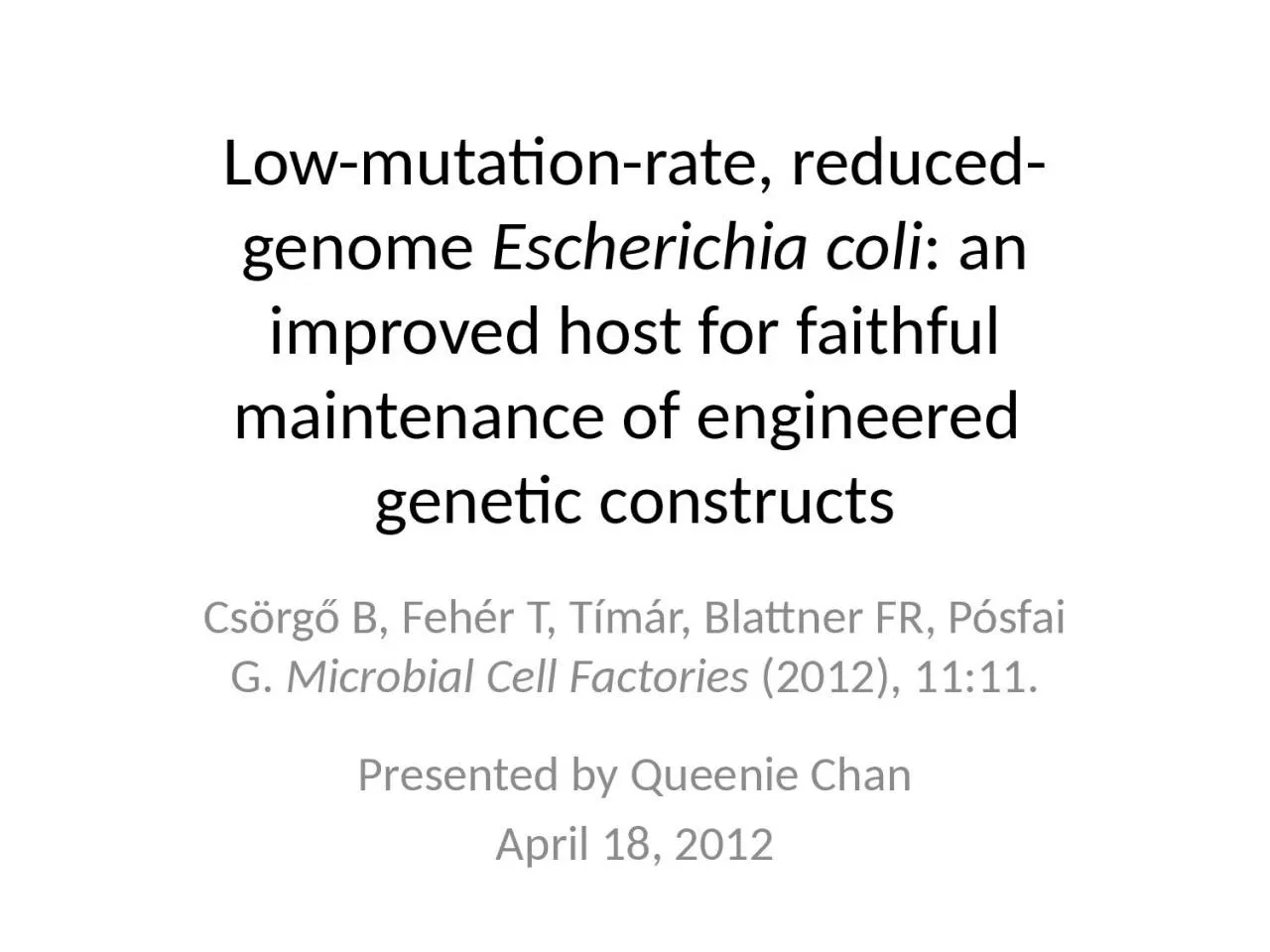

Escherichia coli an improved host for faithful maintenance of engineered genetic constructs Csörgő B Fehér T Tímár Blattner FR Pósfai G Microbial Cell Factories ID: 933474
Download Presentation The PPT/PDF document "Low-mutation-rate, reduced-genome" is the property of its rightful owner. Permission is granted to download and print the materials on this web site for personal, non-commercial use only, and to display it on your personal computer provided you do not modify the materials and that you retain all copyright notices contained in the materials. By downloading content from our website, you accept the terms of this agreement.
Slide1
Low-mutation-rate, reduced-genome Escherichia coli: an improved host for faithful maintenance of engineered genetic constructs
Csörgő
B,
Fehér
T,
Tímár
,
Blattner
FR,
Pósfai
G.
Microbial Cell Factories
(2012), 11:11.
Presented by Queenie Chan
April 18, 2012
Slide2BackgroundGenetic variation In nature: leads to evolution & survival of the fittest
In
lab
conditions
: not favorable, can lead
to
unwanted genotypic and phenotypic alterations
Slide3How do mutations arise?
Stress
SOS response
DNA polymerases: can bypass damaged sites and stalled replication
forks; create mutations
Pol II
Pol IV
Pol V
Slide4GoalCreate chassis that allows stable production of growth-inhibiting biomolecules for applications in synthetic and molecular bio
Why growth-inhibiting biomolecules, specifically?
Mutants usually positively selected for
Slide5ProjectMG1655: wild-type E. coli strainMDS42: reduced genome
E. coli
strain
Genes irrelevant for lab applications
(such as insertion sequences) deleted
Modifying MDS42 by creating variants that are more
genetically stable
Evaluated variants
under
stressful conditions
Evaluated variants transformed with toxic
-product-producing
gene
Slide6Creating Variants
Single
gene deletion
Double
gene deletion
Triple
gene
deletion
Polymerase :
gene
Pol II :
polB
Pol IV :
dinB
Pol V :
umuDC
* p < 0.05 ** p < 0.01 *** p < 0.001
Measuring mutation rates of variants
Slide7Evaluating under Stressful Conditions
Overproduction of GFP
Overproduction of toxic protein
Activation of SOS response
WT
Triple
gene
deletion
Regulator mutants
Slide8Evaluating with Toxic Protein Gene
pSin32 +
BL21(DE3)
mcrBC
MDS42-T7
MDS42pdu-T7
Slide9Test with Toxic Protein Gene Measuring number of mutants in different strains over time
Slide10ConclusionEliminating 3 polymerases involved in SOS response significantly decreases mutation ratesMDS42pdu most genetically stable variation of MDS42
Lowest rate of mutation in response to:
S
tressful conditions
Production of toxic products
Slide11SignificanceDeveloped chassis that is able to stably produce growth-inhibiting biomoleculesApplications:Synthetic & molecular biology
Biotechnology
Cloning
DNA therapeutics
Slide12ConcernsExplanation for MDS42pd’s (double gene deletion) slightly lower mutation rate than MDS42pdu (triple gene deletion) Explanation for difference in
MDS42lexA(S119A
) and MDS42recA (regulator mutants)’s reaction to stress
Inclusion of BL21(DE3
)
Slide13Questions?
Slide14Supplementary Slides:
Creating Variants
Single
gene deletion
Double
gene deletion
Triple
gene
deletion
Verifying that variations do not affect normal cell growth
Regulator
mutants
Slide15Supplementary Slides:Characterizing Types of Mutations
Slide16Supplementary Slides:Checking IPTG Inducibility of strains
pSin32 +
BL21(DE3)
mcrBC
MDS42-T7
MDS42pdu-T7